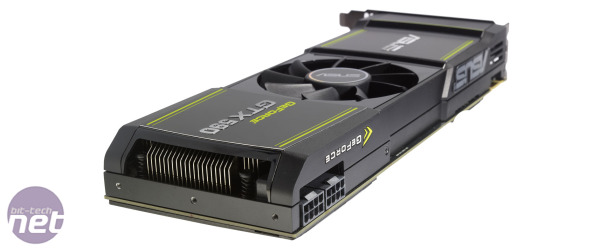
Performance Analysis
While mid-range GPUs are incredibly hard to analyse due to the many other models that compete with them on price, high-end GPUs are dead easy to analyse. The Asus GeForce GTX 590 3GB is even more so, as we can summarise its performance in a word: awesome. That’s not quite the whole story, but it’s pretty much what we’d write if we ever set up Bullet-Point Reviews.com.For example, in Dirt 2 the GTX 590 3GB topped all three performance charts, and by a considerable margin at the crucial super-high resolution of 2,560 x 1,600 (with 4x AA and 16x AF). Even after flicking the Antilles Unlocking Switch (and voiding our warranty), the Radeon HD 6990 4GB couldn’t compete, with a minimum frame rate of 96fps rather than 113fps.
At the most pertinent resolution for cards costing over £500, the GTX 590 3GB was also triumphant in Call of Duty: Black Ops, if only by 2fps over the warranty-void HD 6990 4GB. The minimum frame rate of 84fps was mighty, and the average of 136fps frankly ludicrous. Again, we saw the performance bug at 1,920 x 1,080 though – all the dual-GPU cards struggled with the Full HD resolution, with their minimum frame rates refusing to go beyond 84fps. Oddly, this was despite some epic average frame rates, so we’re genuinely puzzled by this anomaly – no amount of re-testing eradicated the problem; it’s just a quirk of the game.
Our re-introduced and now super-consistent Arma II: Operation Arrowhead test is possibly the most interesting of our four test games, as it’s a system killer. The GTX 590 3GB launched a campaign of shock and awe on our test rig, pulling out playable frame rates even at the crippling resolution of 2,560 x 1,600. Considering that we insist on playing the game with its Very High detail settings and 4x AA, the minimum frame rate of 31fps was incredible.
Even the overclocked HD 6990 4GB struggled at the same settings, managing only a minimum frame rate of 26fps. At 1,920 x 1,080 with 4x AA we saw an incredible minimum of 52fps; a massive 14fps lead over the HD 6990 4GB at stock speeds, and an 11fps lead when the AMD card is in warranty-void mode. Interestingly, the GTX 590 3GB typically achieved lower average frame rates than the HD 6990 4GB. We can’t say for sure whether this means that the graphics driver of the GTX 590 3GB is written to deliver consistent performance, or just that Nvidia’s GPU architecture copes better with the demands of Arma II’s taxing graphics engine.
Only Battlefield: Bad Company 2 found a gap in the GTX 590 3GB’s armour, with the warranty-flouting HD 6990 4GB beating it by 1fps on the minimum frame rate and by 7fps on the average. However, at 1,680 x 1,050 with 4x AA enabled, the HD 6990 4GB micro-stuttered to such a horrendous extent that we’ve had to award it a minimum of 0fps. With this question mark hanging over the reliability of the HD 6990 4GB's driver, the GTX 590 3GB is a safer choice.
Temperatures, power consumption and the cooler
It was no surprise to find that the two GPUs of the GTX 590 3GB ran rather hot, despite the pair of vapour chambers and a high-airflow fan. We saw an idle temperature of 21˚C and a peak temperature of 59˚C – this compares reasonably well to the 60˚C peak temperature of the HD 6990 4GB at stock speed, however. As expected from a graphics card that breaks the PCI-E 2.0 power draw spec, our test system happily chugged through plenty of power – up to 491W, in fact. In contrast, the HD 6990 4GB caused our system to consume 417W of power when at stock speeds and up to 463W when overclocked.All partner cards will use Nvidia’s reference cooler at launch, and most likely for a while after, but there are some characteristics that we don’t like about it that you should remember if you’re planning to buy a card. It won’t surprise you to discover that the card is hardly quiet when working hard – it’s definitely quieter than the cooler of the HD 6990 4GB, but it was still clearly audible over the air-conditioning in our labs, even from 5ft away.
Secondly, as the fan is placed between the two heatsink elements of the cooler, it blows hot air out of both ends, just like the HD 6990 4GB cooler. However, as the internal end of the GTX 590 3GB cooler is completely open, we could feel more airflow going into our test case than being exhausted – fluids will follow the path of least resistance, after all.
This means that a lot of heat is dumped into your case, typically around the hard disk bays. This could be a problem when you consider that hard disks don’t like operating temperatures of over 60˚C. Then again, if you have the money to buy this card, you may well have a bank of SSDs rather than clunky old hard disks.
There are two obvious solutions to the hot air problem. You could reverse a front fan to act as an exhaust for the GTX 590 3GB, or you could water-cool the card. There are waterblocks available from day one, which we'll take a look at in our forthcoming review of Scan's 3XS Scorpion-X PC.

MSI MPG Velox 100R Chassis Review
October 14 2021 | 15:04











Want to comment? Please log in.